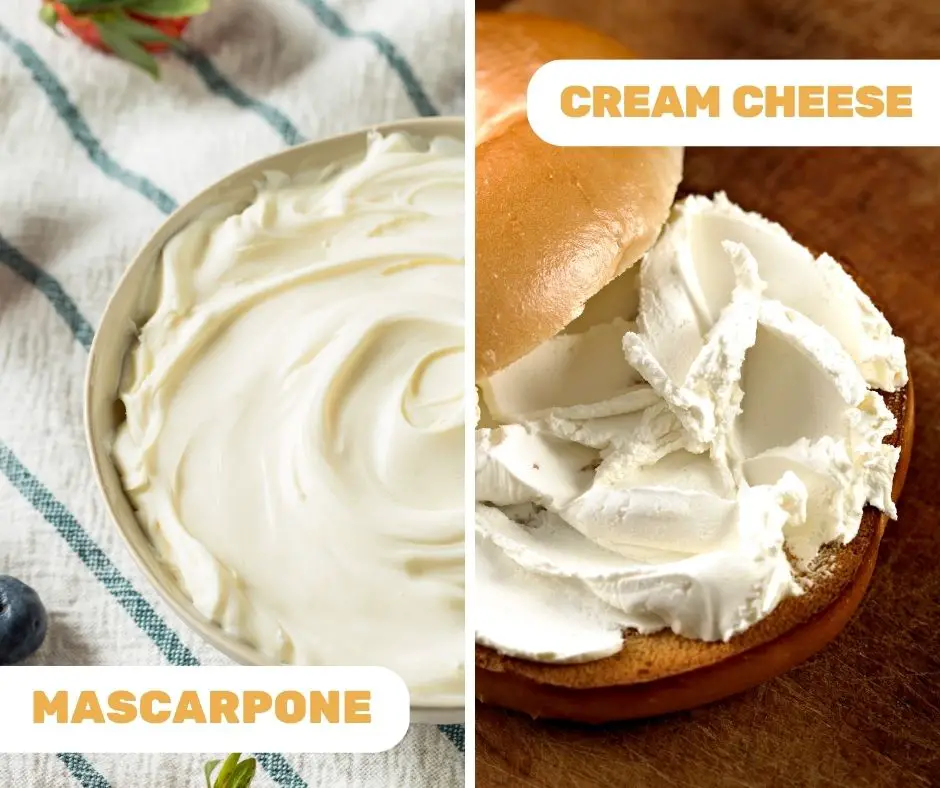Last Updated on February 28, 2023 by Aaron
If you’re a fan of rich, creamy desserts and frosting, you’ve likely come across mascarpone and cream cheese. These two soft cheeses have a lot in common and are often used interchangeably in recipes, but there are some key differences that are worth exploring.
In this article, we will take an in-depth look at the differences between mascarpone and cream cheese, including their origins, flavors, textures, and nutritional values.
| Mascarpone | Cream Cheese | |
| Origin | Italy | United States |
| Flavor | Mild, buttery, slightly sweet | Tangy, sweet, slightly salty |
| Texture | Smooth, creamy | Smooth, slightly firmer |
| Fat Content | High (around 40-50%) | High (around 20-34%) |
| Uses | Tiramisu, cheesecakes, frosting, and dips | Cheesecakes, dips, spreads, and as a bagel topping |
| Ingredients | Cream, citric or tartaric acid, sometimes milk | Cream, milk, salt, cheese culture and often with stabilizers or emulsifiers |
Table of Contents
What is Mascarpone?
Mascarpone is a soft, acid-set cheese that originated in the Lombardy region of northern Italy in the 16th to 17th century. It is made by curdling heavy cream with food-grade acids such as citric or tartaric acid, or lemon juice for homemade mascarpone, which gives it a hint of sour flavor and a smooth, velvety texture.
Mascarpone is traditionally used in Italian desserts such as tiramisu and cannoli, but it can also be used in savory dishes such as risotto and pasta.
Here is an example of mascarpone ingredients manufactured by BelGioioso: Pasteurized Milk and Cream, Citric Acid.
The exact ingredients may vary on the brand.
Mascarpone has a very high-fat content. Most of the store-bought mascarpone cheese brands, including the BelGioioso 8-oz mascarpone cup, have a fat content of around 40-50%. This higher fat content gives it a richer buttery flavor than cream cheese.
What is Cream Cheese?
Cream cheese, on the other hand, was first developed in the United States in the late 1800s. It is made by blending milk and cream with cheese culture (lactic acid bacteria), which gives it a slightly tangy flavor and a smooth, spreadable texture. learn more about how it is made here.
Cream cheese is commonly used in American desserts such as cheesecake and frosting, as well as in savory dishes and also dips and spreads.
The ingredients for Philadelphia cream cheese is listed as followed: Pasteurized Milk and Cream, Whey Protein Concentrate, Whey, Salt, Carob Bean Gum, Xanthan Gum, Guar Gum, Natamycin (a Natural Mold Inhibitor), Vitamin A Palmitate, Cheese Culture.
It contains a handful of additives. Some other healthier brands as we discussed in this healthiest cream cheese article did not use as many additives or stabilizers.
Most Cream cheese spreads is having a fat content range of 20-34%, e.g. Philadelphia cream cheese spread is around 25%, which is much lower than mascarpone. In addition, cream cheese is always available in low-fat versions.
Differences in Taste and Texture: Can Substitute?
Mascarpone has a delicately thicker, creamier flavor that is often described as buttery or nutty. The extra fat content provided an incredibly smooth and rich mouthfeel that is similar to double cream. In contrast, cream cheese that we normally use on bagels tends to have a tangy, more acidic flavor, and it is slightly firmer than mascarpone.
With that, mascarpone is often used as a filling or a topping for desserts, while cream cheese is commonly used as a spread or a base for the frosting.
While they are not the exact substitute for each other, you can pretty much swap out the mascarpone with full-fat cream cheese at anytime, and successfully use them in one-to-one ratio for almost any recipe called. Alternatively, you can use heavy whipping cream or creme fraiche, or a combination in equal parts and adjust the other ingredients as needed.
Preferences and Uses of Desserts and Frostings
Both mascarpone and cream cheese have their place in the kitchen and are used in a wide range of sweet desserts and frostings. Mascarpone is often used in Italian desserts like tiramisu, as well as in frostings for cakes and cupcakes. Its smooth, creamy texture makes it a great ingredient for mousse and other light, airy desserts.
Cream cheese is commonly used in cheesecake, frosting, and icing. Its tangy flavor makes it a great ingredient for sweet and savory dishes alike. Cream cheese frosting is a popular choice for red velvet cake, carrot cake, and many other baked goods.
Healthier Options
While mascarpone and cream cheese are both delicious, they are not the healthiest options when it comes to cheese. Both are high in calories and fat, so it’s best to use them in moderation. Two popular brands and their nutrition values were tabulated as table below:
| Mascarpone (1-ounce) | Cream Cheese (1-ounce) | |
| Calorie | 120 | 70 |
| Fat (g) | 14 | 7 |
| Saturated Fat (g) | 10 | 4 |
| Cholesterol (mg) | 40 | 20 |
| Sodium (mg) | 10 | 115 |
| Carbohydrates (g) | 0 | 1 |
| Protein (g) | 2 | 1 |
| Calcium (mg) | 40 | 40 |
One ounce of mascarpone contains around 120 calories, while one ounce of cream cheese contains around 70 calories. If you’re looking to cut back on calories or look for a healthier option for your desserts or frosting, consider using Greek yogurt, low-fat cream cheese, or even ricotta cheese. These options have a lower calorie and fat content, and they can be just as delicious as mascarpone and cream cheese.
Furthermore, for every tablespoon (14g) of mascarpone, there is 5 grams of saturated fat out of 7 grams of total fat. It means that every tablespoon of mascarpone you added to your food will take away 25% of the daily allowance of saturated fat. That’s huge!
In contrast, the same serving of cream cheese will only give you about 10% daily saturated fat — still fairly high but at about 15% less! You can even try to opt for the low-fat or lite version, which will give you 1/3 less fat.
It’s also worth noting that mascarpone does not use salt, and therefore lower in sodium.

